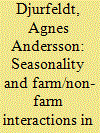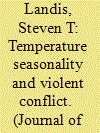|
|
|
Sort Order |
|
|
|
Items / Page
|
|
|
|
|
|
|
| Srl | Item |
| 1 |
ID:
113109


|
|
|
|
|
| Publication |
2012.
|
| Summary/Abstract |
Measuring nationwide progress of counterinsurgency operations in Afghanistan using violence trends is difficult due to several factors: aggregation of data to the national level may obfuscate disparate local trends; the observed seasonality in violence makes comparisons difficult and may obscure progress; and short-term spikes or troughs - attributable to weather, military operations and tempo, or holiday periods - heavily influence simple averaging schemes. Despite these challenges, proper understanding of violence statistics is critical to estimating the effectiveness of military forces added during a surge or redeployed as part of transition. This article explores methods for analyzing observed violence trends to identify causal factors, to provide a comparable baseline, and to inform assessments at appropriate levels of aggregation. One methodology for seasonal adjustment of violence data is discussed and shown to provide a logical baseline for examining trends. An ordinary least squares regression model is developed and implemented using time-series violence data.
|
|
|
|
|
|
|
|
|
|
|
|
|
|
|
|
| 2 |
ID:
111606


|
|
|
|
|
| Publication |
2012.
|
| Summary/Abstract |
This article considers the distributional consequences of seasonality by analysing the links between non-farm incomes, commercialisation within agriculture, and variations in consumption burdens and expenditures at the household level. The common focus in the literature on non-farm incomes as levellers of seasonality and sources of risk minimisation is complemented by perspectives which consider how seasonality affects and is handled by households depending on their broader livelihood situations. To this perspective is also added a consideration of in-kind transfers and transactions. The article uses a mixed methods approach, drawing on data from two villages in Western Kenya. The lack of non-farm sources of income and the variation over time in consumption burdens aggravate the seasonal aspects of the agricultural production cycle for poorer households. By contrast, the interaction between farm and non-farm sources of income enables wealthier households to profit from seasonality in relation to agricultural markets, while providing the basis for meeting both farm and non-farm expenditures.
|
|
|
|
|
|
|
|
|
|
|
|
|
|
|
|
| 3 |
ID:
134153


|
|
|
|
|
| Publication |
2014.
|
| Summary/Abstract |
Current climate change research suggests that certain seasonal weather patterns will be extended and others attenuated as global temperature increases. This is important because seasonal temperature change affects both the scarcity of resources during certain times of the year and the overall mobility of people living in countries that have seasonality. Consequently, these seasonal changes have implications for the onset of violent conflict, particularly as it relates to distinguishing when, where, and how it is most likely to occur. This article evaluates the relationship between monthly temperature changes, civil war onset, and various, less-organized conflict events, offering theoretical expectations for how seasonal changes and climate aberrations are related to an increased risk of violence. The results show that prolonged periods of stable, warm weather are consistently associated with an increased risk of civil war onset and non-state conflict. These findings are best explained through the strategic viability mechanism of temperature change, which allows actors to resolve their collective action problems that are often associated with poor weather conditions, while simultaneously increasing their strategic and behavioral incentives for engaging in violent conflict. Warm weather generates more resources for rebel looting and permits predictability for coordinating troop movements and strategy development. These findings are particularly salient in areas of the world affected by strong seasonality, where prolonged extensions of warm weather conditions would be regarded as both peculiar and attractive for participating in violent action. Although these findings are notable, even under the most extreme climate change scenarios, the substantive effects for these relationships are comparatively minor relative to other well-known intrastate Conflict Covariates.
|
|
|
|
|
|
|
|
|
|
|
|
|
|
|
|
|
|
|
|
|